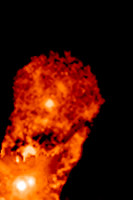 A visual band light curve for XZ Tauri. The main plot shows the long-term variability, and the inset shows the year 2000 superflare on the north star. Adapted from Dodin et al. (2016) [1] and Coffey et al. (2004). [2] | |
| Observation data Epoch J2000.0 Equinox J2000.0 | |
|---|---|
| Constellation | Taurus |
| Right ascension | 04h 31m 40.08690s [3] |
| Declination | +18° 13′ 56.6424″ [3] |
| Apparent magnitude (V) | 10.40 [4] |
| Characteristics | |
| Spectral type | M2.0 + M3.5 [5] |
| Astrometry | |
| Proper motion (μ) | RA: 9.1 [6] mas/yr Dec.: −17.8 [6] mas/yr |
| Distance | 460 ly (140 [7] pc) |
| Orbit [8] | |
| Primary | A [a] |
| Companion | B |
| Period (P) | 155 yr |
| Semi-major axis (a) | 0.172+0.002 −0.003″ |
| Eccentricity (e) | 0.742+0.025 −0.034 |
| Inclination (i) | 0.0° |
| Argument of periastron (ω) (secondary) | −42.2+2.0 −4.7° |
| Details [5] | |
| A [a] | |
| Mass | 0.37 M☉ |
| Radius | 1.1 R☉ |
| Luminosity | 0.17 L☉ |
| B | |
| Mass | 0.29 M☉ |
| Radius | 1.7 R☉ |
| Luminosity | 0.31 L☉ |
| Temperature | 3,550 [7] K |
| Age | 4.6 [7] Myr |
| Other designations | |
| XZ Tau, GSC 01269-00171 [9] | |
| Database references | |
| SIMBAD | data |
XZ Tauri is a binary system approximately 460 light-years away in the constellation Taurus. The system consists of two T Tauri stars orbiting each other about 6 billion kilometers apart (roughly the same distance as Pluto is from the Sun). The system made news in 2000 when a superflare was observed in the system.
Contents
A third star, component C, has been observed at a separation of 0.09″ , but subsequent observations failed to find it. [10] [8] The T Tauri star HL Tauri, 23″ away, is also sometimes listed as a companion. [9]
The discovery by Pelageya Fedorovna Shajn, that XZ Tauri is a variable star, was announced in 1928. [11]

